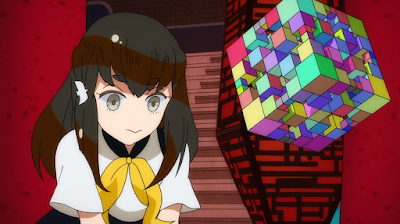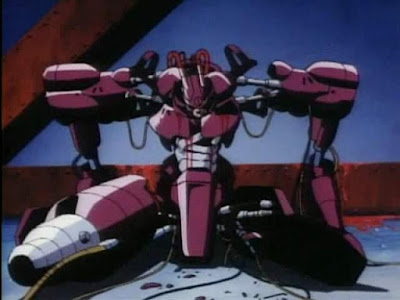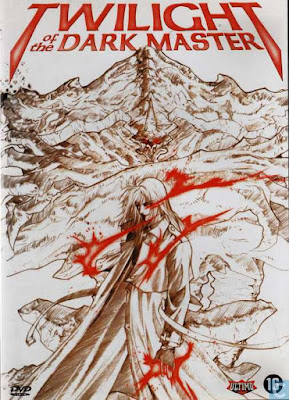 |
| From https://upload.wikimedia.org/wikipedia/en/thumb/4/4c/Gatchman_ Crowds_promotional_image.jpg/230px-Gatchman_Crowds_promotional_image.jpg |
Director: Kenji Nakamura
Screenplay: Kenji Sugihara,
Shinsuke Onishi and Toshiya Ono
Voice Cast: Maaya Uchida (as
Hajime Ichinose); Daisuke Namikawa (as Jō Hibiki); Ryota Ohsaka (as Sugune
Tachibana); Aya Hirano (as Paiman); Ayumu Murase (as Rui Ninomiya); Daisuke
Hosomi (as O.D); Kotori Koiwai (as Utsu-tsu); Mamoru Miyano (as Berg Katze)
Based on the Tatsunoko Productions created franchise
Viewed in Japanese with English Subtitles
Remakes and reinterpretations are
common in anime. Resurrecting a classic franchise or character makes practical
sense - the potential nostalgia can sell it but also a complete
reinterpretation can bring an old franchise back to life for a new audience.
This is only a problem for me, as it has been the case for mainstream cinema,
when everything is this with no
original ideas. Anime follows comics books, and characters have been
resurrected in manga form too, in that it's as much to bring a franchise back
to relevance or appealing to an older fan base as it is to capitalise on a
brand in many of the cases I've seen. Depending on what I watch for the blog,
I'll end up covering multiple versions of the same character even if they're
not necessarily popular in the West - Lupin the 3rd, Sailor Moon, Cutey Honey,
the Dirty Pair, Golgo 13 and an entire Japanese Justice League of heroes and
anti-heroes, even the villains likely to be brought back in a fresh lick of
paint for a new TV show or spin-off.
Gatchaman is known in the West as Battle
of the Planets, with the franchise in Japan a jewel in the crown of Tatsunoko Productions, who've
specialised in superhero characters like them alongside other genres of anime. Gatchaman Crowds is pretty radical,
however, in comparison to the previous version or what you'd expect for a
superhero story.
 |
| From http://vignette2.wikia.nocookie.net/scienceninjateamgatchaman/images /0/05/Gatchaman-crowds-hajime-ichinose-gatchaman-costume.png/revision/latest?cb=20131129234130 |
A carefree high school girl with
her head in the clouds, Hajime Ichinose, is suddenly brought into secret
Gatchman organisation to become the newest member. Hilariously, the series
never attempts to explain why she was chosen in this season, as if the
screenplay wisely decided to excise the part of storytelling which bogs it down
where it has to establish the origins of a character. Some of it is missed, as
I will get into later, but in cramming all the exposition of what the Gatchamen
are in the first fifteen minutes of the first episode allows it to get on with
the meat of the show. All that matters is that Hajime now has a special
electronic notebook which is connected directly to her consciousness, able to
turn her into an armoured warrior to fight aliens. Amongst this team there are
three good aliens - the warmhearted O.D., the mysterious Utsutsu Miya who is melancholic
and can duplicate herself amongst other abilities, and their leader Paiman, a
small alien that looks like a panda - and two fellow human beings, the civil
office worker Joe Hibiki and Sugane Tachibana, a fellow high school student who
is continually mortified by Hajime's behaviour. When she befriends the aliens
they're supposed to be killing, to the horror of almost everyone, a real threat
appears in the form of the alien Berg Katze, a flamboyant shape-shifter who
intends to get humanity to destroy themselves through GALAX, an elaborate
community spearheaded by Rui Ninomiya which the later intends to use to make
the world a better place.
 |
| From http://2.bp.blogspot.com/-9ut29gkB7dk/UhRYzXqNolI/ AAAAAAAAIWk/t618n2E_PJo/s1600/gatchamancrowds2.png |
Gatchman Crowds manages to be quite a bit different in the area of
superhero storytelling, where the issue of ordinary society is given greater
importance than the superhero tropes themselves. How this deals with technology
is a significant factor; even in western superhero films I've seen, including
self-referential works like Kick-Ass
(2010), you don't get as extensive a viewpoint on technology like the web
in this sort of universe like in this. GALAX, which through a game-like
mentality encourages the normal public to help each other in crises and offers
knowledge to the populous, is both unsettling in its all encompassing nature on
people's lives but also, eventually, becomes conduit to bring humanity back
into technology. The series shows however the complications of social media
within the exaggerated context of superheroes and aliens, ultimately about the
moral issues of taking order into one's own hands when society is far from
perfect. Mobile phones, discussion forums, even YouTube become preverbal minefields where a hero can become a
villain, and an attempt to inform the population of a threat has to struggle
against text bubbles like those on Facebook
from random bystanders insulting the people making the warning.
 |
| From http://kevo.dasaku.net/wp-content/uploads/2013/07/rubixcube.png |
What could be seen as a
conservative message, where every Japanese citizen becomes happy and helps each
other for the sake of the nation, is complicated by the fact that the
technology, like governments, can be extremely flawed and its common sense that
prevails if one wants to improve the world. Problems are furthered by Rui
Ninomiya given certain members of the public the access to "Crowds",
the ability to protect their minds into the bodies of hulking bobble headed
figures meant to help in emergency situations, both able to be used for virtue
and destruction depending on the individual whims of users. Gatchaman Crowd in a light hearted work
is yet about the dangers of ego and abusing power, and for all its bright
colours, there's unsettling moments where suddenly a random knifing spree takes
place, the evil alien responsible as much a metaphor for the worse in people as
well as a truly evil and charismatic villain for boo.
 |
| From http://commiesubs.com/wp-content/uploads/2013/07/ wpid-Commie-Gatchaman-Crowds-03-CFBDF788.mkv.jpg |
It's a shame this particular
story is only twelve episodes long. More anime series are this length now, and
while this helps avoid over padding them with non-essential fluff, this
particular series while it thankfully jettisons bad clichés of the superhero
genre could've been fun if it had twenty four episodes. It could've done with
indulging in the monster of the week episode at least once throughout its
length and allowed the Gatchaman lifestyle for Hajime to been seen in more
detail. At least enough to let the characters have more screen time and let the
plot, where she encourages her group to leave secrecy and name themselves to
the public, to have greater meaning and adding to the mellow irony of the fact
her first suggestion to do this is to go to a nursery school and entertain the
children with their superhero transformations. It would've been more
interesting to see Utsutsu's plight as a figure whose life saps away because of
her powers, as the dialogue suggests, and to see more moments of Paiman's
frustrations as team leader, only shown when he decides to get drunk and chow
on snacks after running away from a battle in fear previously.
 |
| From http://animeism.org/web/wp-content/uploads/2013/08/ Screen-shot-2013-08-23-at-12.34.58-PM.png |
There are clichés however I'm
thankfully, as mentioned, were axed and what is put in their place are some of
the best aspects of the series. While she could come off as too perfect a
person, a "Mary Sue" to quote fan fiction terminology, Hajime is
refreshing as a protagonist with no dark past or anxieties like so many generic
heroes and heroines. Especially for a female protagonist it's refreshing to
have one who is written with a traumatic past. It's not jarring for her to
never cry or feel anger, completely happy even when being goaded by the villain.
It's as if the anime stock character of the airheaded female character, like
Osaka from Azumanga Daioh (2002),
whose head is in an entirely different reality was made the heroine and turns
out to be more wiser than anyone else because of this. You'd want to date a
girl like this if she existed as a real person, a nerd obsessed with note books
and who goes to collage session which have every civil service leader amongst
the group, and thankfully she's far from the useless moe stereotype of the cute
girl or a magical pixie girl who's obnoxious in her chirpiness, instead someone
who can still be blunt with a smile on her face even to the villain. Also
wonderful if that this is the first explicit example of gender fluidity in
anime that I'll cover. Amongst other interesting character details in other
areas, you find out that Rui Ninomiya is actually a young man who dresses like
a woman into Gothic Lolita clothing in public, this fact brought up casually a
few times but never a distinct feature of her when it's the Faustian scenario
between her and Berg Katze that's the real existential crisis. Gender and
sexuality has already been fluctuated in some of the anime I've already
covered, but it can be more explicit in these works even in a moment of comedy.
One of the reasons I still am a fan of manga and anime is because of how it
subverts various things continually including issues like this.
 |
| From http://moe-alternative.net/wp-content/uploads/2013/ 09/vlcsnap-2013-09-02-00h31m50s47.jpg |
Gatchaman Crowds this year got a sequel series, and by all accounts
it has turned out to be just as good as this was. In terms of the visuals and
animation, the first series does stand out with a distinct personality, more pronouncedly
colourful in its realistic city setting than other anime, with a sense of
dynamic energy to the animation even in the use of 3D models that is
infectious. Everything that it manages to sneak into a breezy tone in terms of
story, all the commentary on technology, is a huge factor to enjoying the
series as it does manage to have a great deal of insight in-between in its light-heartedness.
The only thing I can grumble about is how I would've liked more than twelve
episodes for this prequel's story, that it could've melded the tradition of the
classic Gatchman with this new
version with ideas a plenty in its head for commentary, making its ending no
longer a sudden one but one with greater bombast. Everything that stands as it
is, though is exceptionally watchable. That I immensely enjoyed what there was
makes my criticism of its shortness actually a paradoxical compliment, wanting
a lot more of the best things. Even if it could've lead to a drop in script and
animation quality, it would've been a gamble worth taking to get this story in
greater depth. Instead I'll wait impatiently for the sequel to get home theatre
release in the UK.









































